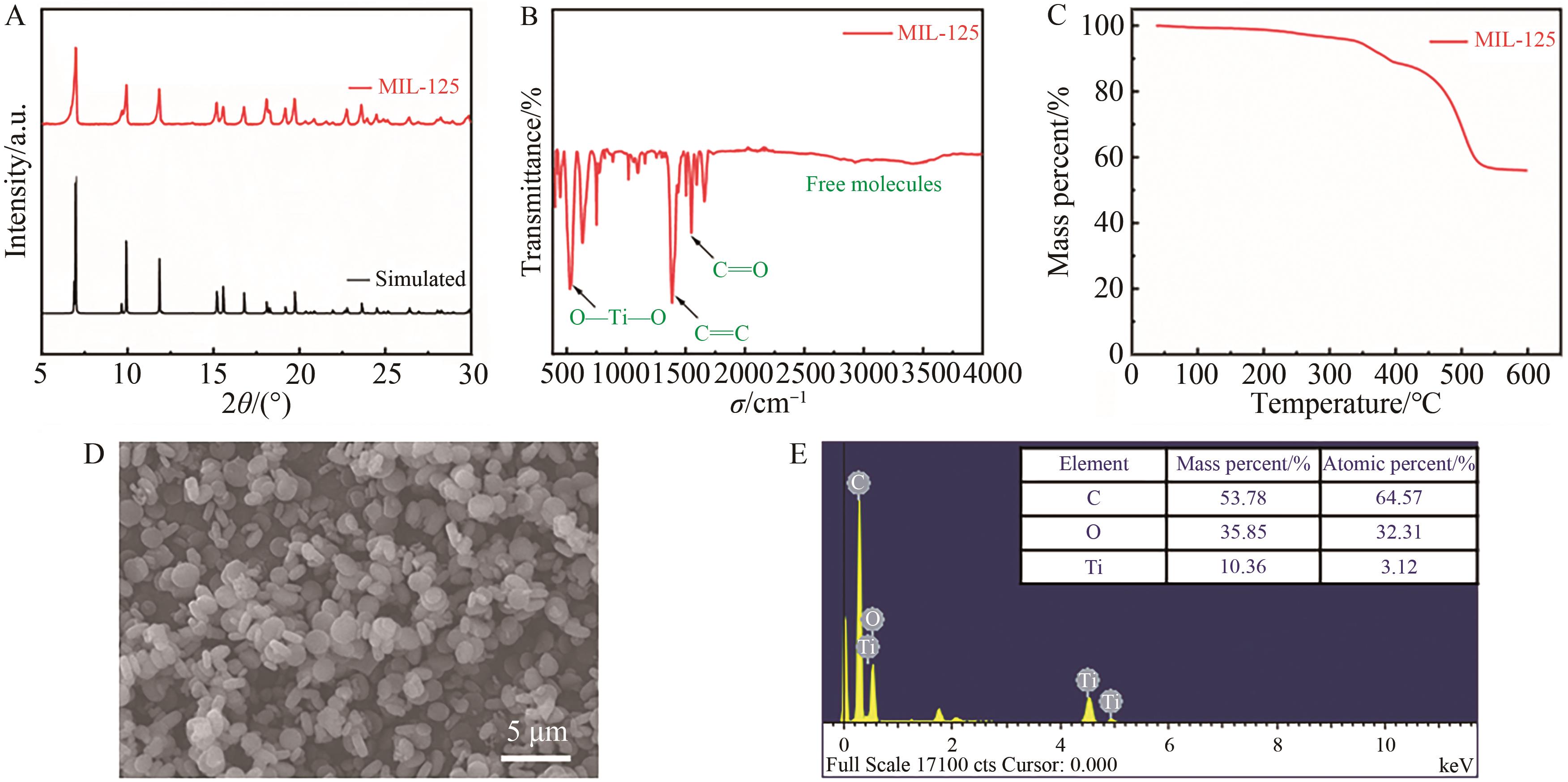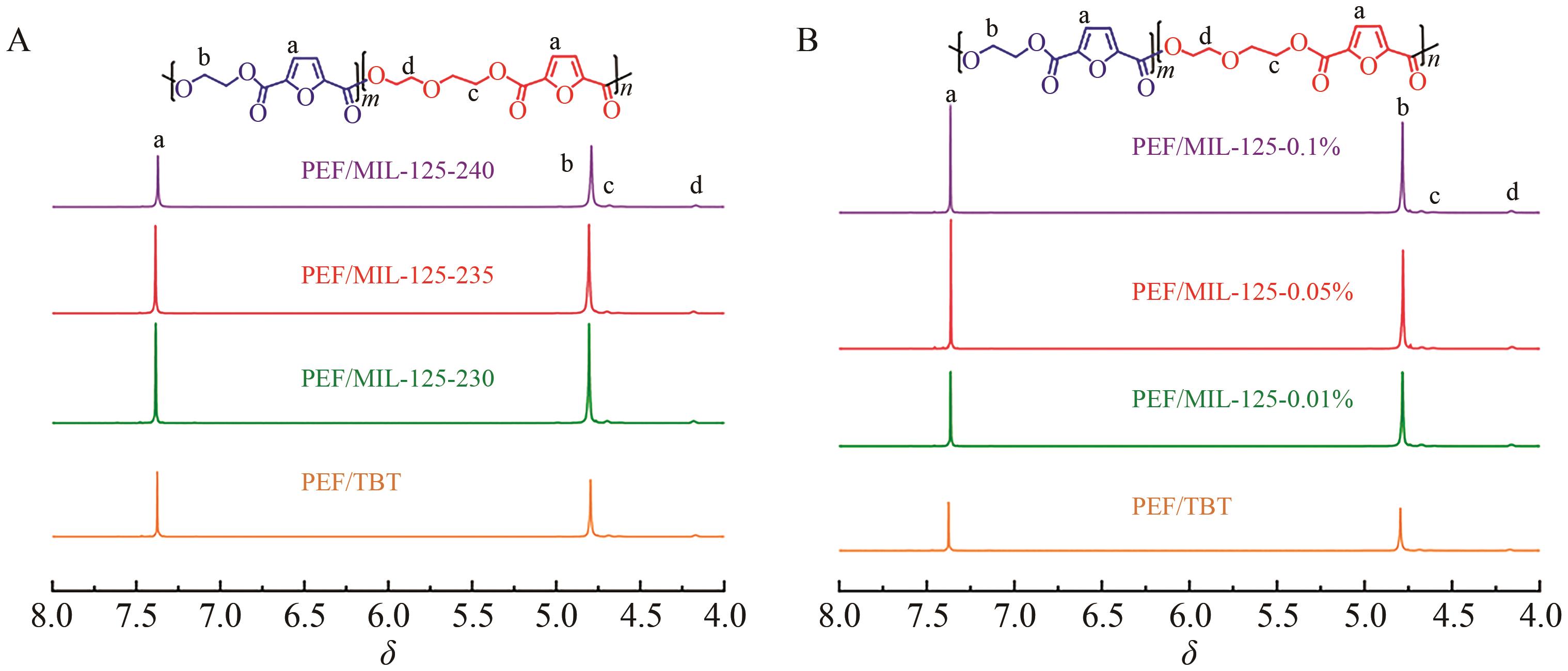
Chinese Journal of Applied Chemistry ›› 2024, Vol. 41 ›› Issue (11): 1596-1604.DOI: 10.19894/j.issn.1000-0518.240122
• Full Papers • Previous Articles Next Articles
Synthesis and Alcoholysis of Bio-Based Poly(ethylene 2,5-furandicarboxylate) Catalyzed by Ti-MOF
Li-Xin LIU1,2, Shu-Hua YAO1( ), Xuan CAO1, Guan-Nan ZHOU2, Rui WANG2, Lu LI2(
), Xuan CAO1, Guan-Nan ZHOU2, Rui WANG2, Lu LI2( )
)
- 1.Liaoning Engineering Research Center for Treatment and Recycling of Industrially Discharged Heavy Metals,Shenyang University of Chemical Technology,Shenyang 110142,China
2.Division of Energy Materials (DNL 22),Dalian Institute of Chemical Physics,Chinese Academy of Sciences,Dalian 116023,China
-
Received:2024-04-12Accepted:2024-08-30Published:2024-11-01Online:2024-12-04 -
Contact:Shu-Hua YAO,Lu LI -
About author:lilu528@dicp.ac.cn
yaoshuhua@syuct.edu.cn;
-
Supported by:the National Key Research and Development Programme of China(2022YFC2105800);the Science and Technology Programme of Liaoning Province(2022JH24/10200024);the Basic Research Project of the Department of Education of Liaoning Province(JYTQN2023373);the Medical-Industrial Joint Innovation Fund(DMU-1&DICP UN202210)
CLC Number:
Cite this article
Li-Xin LIU, Shu-Hua YAO, Xuan CAO, Guan-Nan ZHOU, Rui WANG, Lu LI. Synthesis and Alcoholysis of Bio-Based Poly(ethylene 2,5-furandicarboxylate) Catalyzed by Ti-MOF[J]. Chinese Journal of Applied Chemistry, 2024, 41(11): 1596-1604.
share this article
Add to citation manager EndNote|Ris|BibTeX
URL: http://yyhx.ciac.jl.cn/EN/10.19894/j.issn.1000-0518.240122
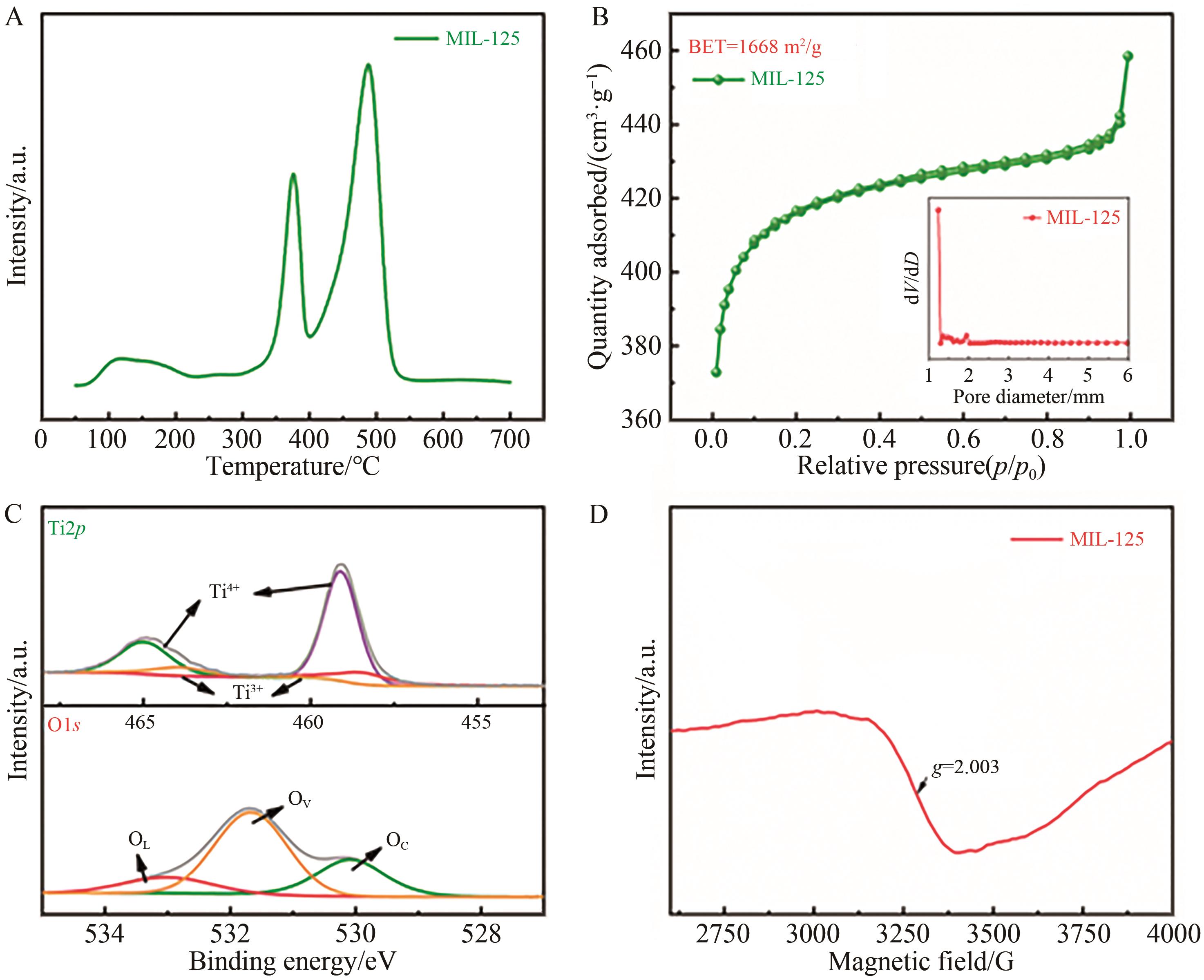
Fig.3 (A) NH3-TPD analysis of MIL-125; (B) The N2 adsorption/desorption isotherms analysis for MIL-125; (C) XPS analysis for MIL-125; (D) EPR analysis for MIL-125
| No. | Compound | Td-5%/℃ | Tg/℃ | φ(DEGF)/% | Mn | Mw | PDI |
|---|---|---|---|---|---|---|---|
| 1 | PEF/MIL-125-230 | 375.7 | 87.6 | 3.0 | 3.8×104 | 7.2×104 | 1.9 |
| 2 | PEF/MIL-125-235 | 373.8 | 85.6 | 3.3 | 3.7×104 | 7.4×104 | 2.0 |
| 3 | PEF/MIL-125-240 | 371.0 | 86.4 | 5.0 | 3.2×104 | 6.6×104 | 2.0 |
| 4 | PEF/MIL-125-0.01% | 375.7 | 87.6 | 3.0 | 3.8×104 | 7.2×104 | 1.9 |
| 5 | PEF/MIL-125-0.05% | 373.1 | 85.6 | 4.1 | 3.2×104 | 5.7×104 | 1.7 |
| 6 | PEF/MIL-125-0.1% | 370.0 | 87.3 | 4.7 | 3.0×104 | 5.6×104 | 1.8 |
| 7 | PEF/TBT | 361.5 | 86.4 | 5.1 | 2.6×104 | 6.3×104 | 2.4 |
Table 1 Comparison of catalytic performances of MIL-125 with TBT catalysts in PEF synthesis
| No. | Compound | Td-5%/℃ | Tg/℃ | φ(DEGF)/% | Mn | Mw | PDI |
|---|---|---|---|---|---|---|---|
| 1 | PEF/MIL-125-230 | 375.7 | 87.6 | 3.0 | 3.8×104 | 7.2×104 | 1.9 |
| 2 | PEF/MIL-125-235 | 373.8 | 85.6 | 3.3 | 3.7×104 | 7.4×104 | 2.0 |
| 3 | PEF/MIL-125-240 | 371.0 | 86.4 | 5.0 | 3.2×104 | 6.6×104 | 2.0 |
| 4 | PEF/MIL-125-0.01% | 375.7 | 87.6 | 3.0 | 3.8×104 | 7.2×104 | 1.9 |
| 5 | PEF/MIL-125-0.05% | 373.1 | 85.6 | 4.1 | 3.2×104 | 5.7×104 | 1.7 |
| 6 | PEF/MIL-125-0.1% | 370.0 | 87.3 | 4.7 | 3.0×104 | 5.6×104 | 1.8 |
| 7 | PEF/TBT | 361.5 | 86.4 | 5.1 | 2.6×104 | 6.3×104 | 2.4 |
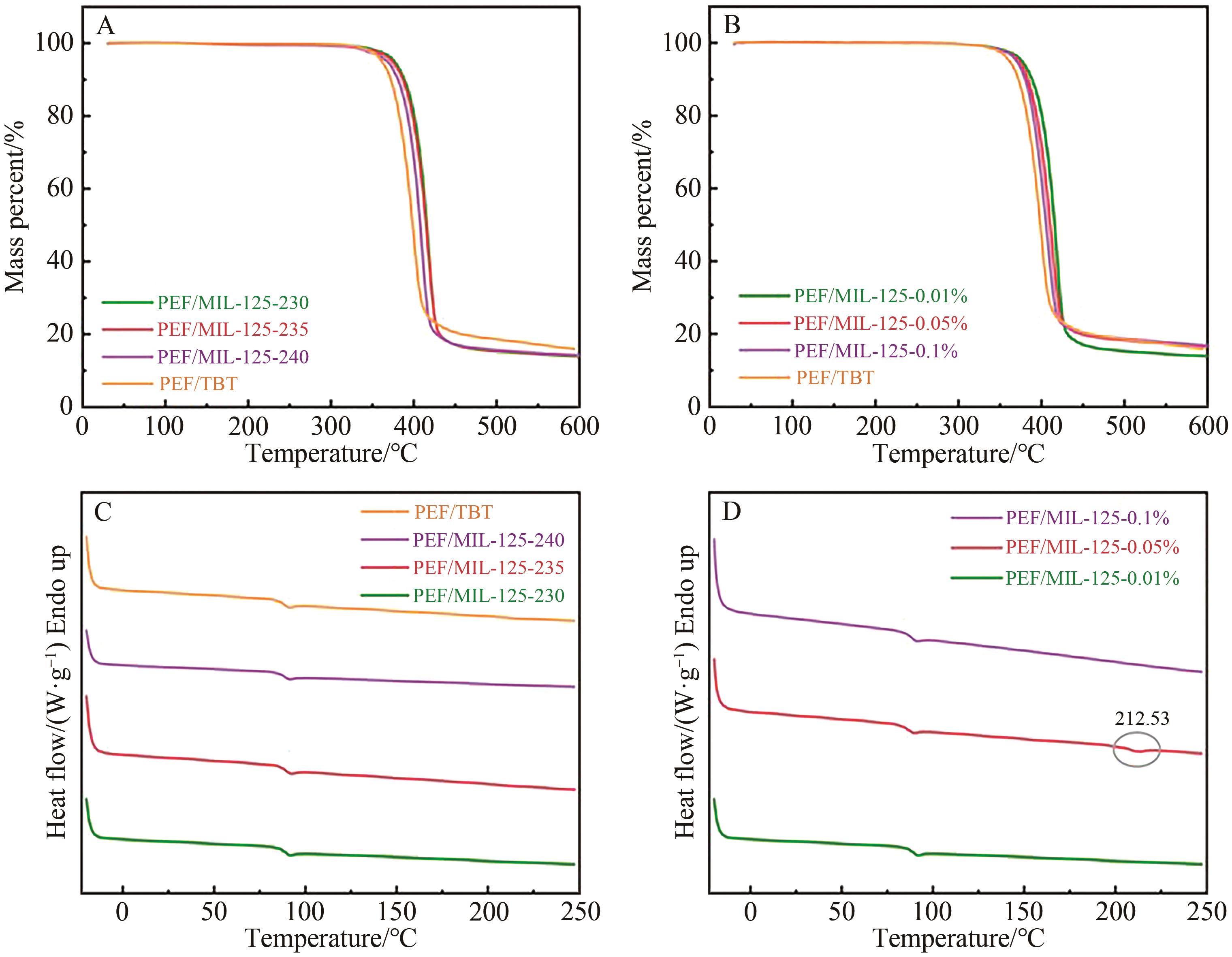
Fig.4 (A) TGA graph of the effect of polycondensation temperature on the thermal decomposition temperature of PEF; (B) TGA graph of the effect of catalyst dosage on the thermal decomposition temperature of PEF; (C) DSC secondary heating curve of the effect of polycondensation temperature on the thermal performance of PEF; (D) DSC secondary heating curve of the effect of catalyst dosage on the thermal performance of PEF
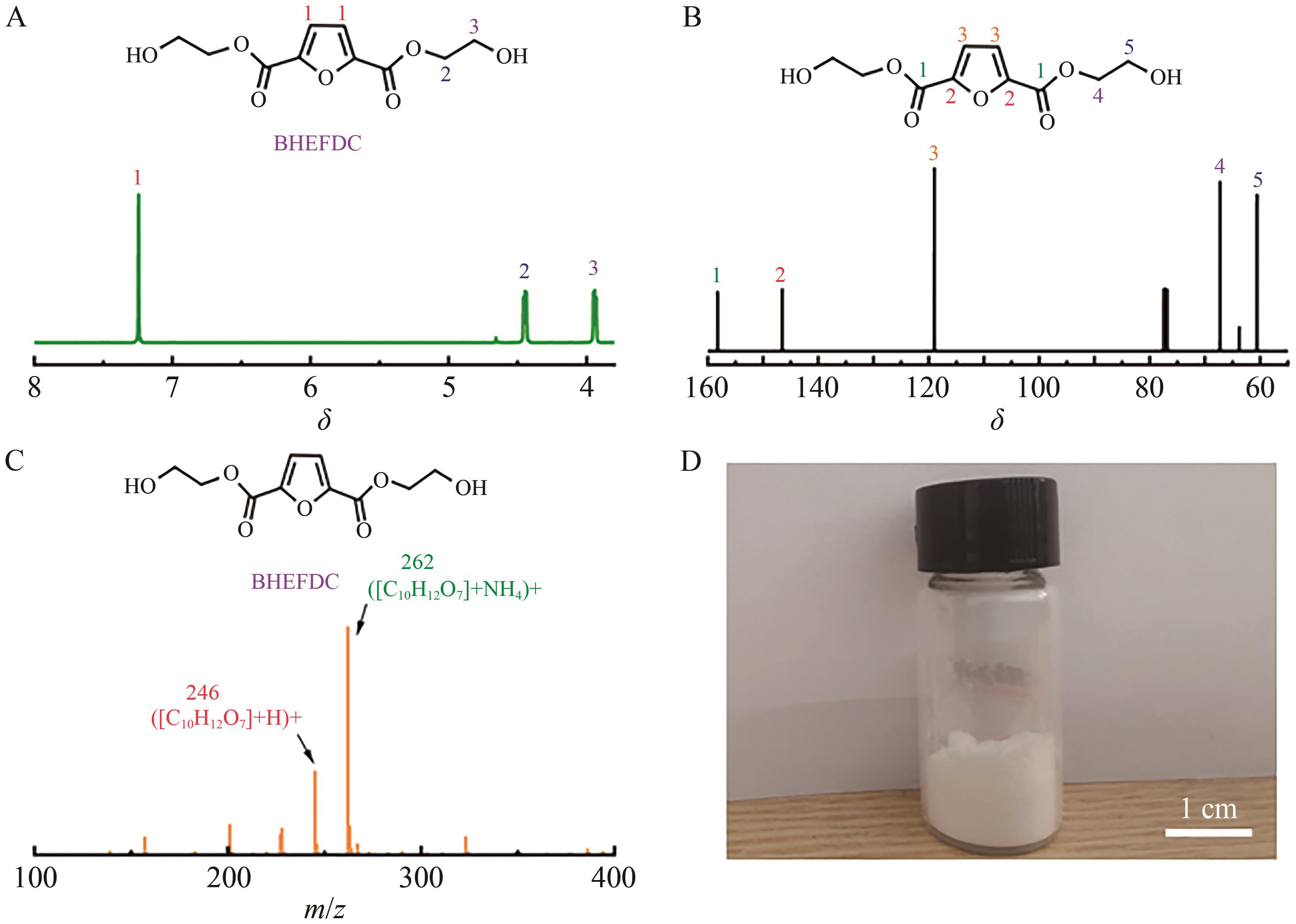
Fig.7 (A) Catalytic ethylene glycol alcoholysis test of PEF/MIL-125-0.01%, 1H NMR; (B) 13C NMR; (C) MS of the intermediate BHEFDC; (D) Intuitive product diagram
| 1 | FEI X, WANG J, ZHU J, et al. Biobased poly(ethylene 2,5-furancoate): no longer an alternative, but an irreplaceable polyester in the polymer industry[J]. ACS Sustainable Chem Eng, 2020, 8(23): 8471-8485. |
| 2 | CUI Y, DENG C, FAN L, et al. Progress in the biosynthesis of bio-based PET and PEF polyester monomers[J]. Green Chem, 2023, 25(15): 5836-5857. |
| 3 | MIAH M R, DONG Y, WANG J, et al. Recent progress on sustainable 2,5-furandicarboxylate-based polyesters: properties and applications[J]. ACS Sustainable Chem Eng, 2024, 12(8): 2927-2961. |
| 4 | BANELLA M B, BONUCCI J, VANNINI M, et al. Insights into the synthesis of poly(ethylene 2,5-furandicarboxylate) from 2,5-furandicarboxylic acid: steps toward environmental and food safety excellence in packaging applications[J]. Ind Eng Chem Rsc, 2019, 58(21): 8955-8962. |
| 5 | QU X, ZHOU G, WANG R, et al. Synergistic catalysis of imidazole acetate ionic liquids for the methanolysis of spiral poly(ethylene 2,5-furandicarboxylate) under a mild condition[J]. Green Chem, 2021, 23(4): 1871-1882. |
| 6 | FINELLI L, LORENZETTI C, MESSORI M, et al. Comparison between titanium tetrabutoxide and a new commercial titanium dioxide based catalyst used for the synthesis of poly(ethylene terephthalate)[J]. J Appl Polym Sci, 2004, 92(3): 1887-1892. |
| 7 | GRUTER G J, SIPOS L, ADRIANUS DAM M. Accelerating research into bio-based FDCA-polyesters by using small scale parallel film reactors[J]. Comb Chem High Throughput Screen, 2012, 15(2): 180-188. |
| 8 | TERZOPOULOU Z, KARAKATSIANOPOULOU E, KASMI N, et al. Effect of catalyst type on molecular weight increase and coloration of poly(ethylene furanoate) biobased polyester during melt polycondensation[J]. Polym Chem, 2017, 8(44): 6895-6908. |
| 9 | SUN Y, JI H, SUN Y, et al. Synergistic effect of oxygen vacancy and high porosity of nano MIL-125(Ti) for enhanced photocatalytic nitrogen fixation[J]. Angew Chem Int Ed, 2024, 63(3): e202316973. |
| 10 | SAFARIFARD V, RODRÍGUEZ-HERMIDA S, GUILLERM V, et al. Influence of the amide groups in the CO2/N2 selectivity of a series of isoreticular, interpenetrated metal-organic frameworks[J]. Crystal Grow Design, 2016, 16(10): 6016-6023. |
| 11 | RAVON U, DOMINE M E, GAUDILLÈRE C, et al. MOFs as acid catalysts with shape selectivity properties[J]. New J Chem, 2008, 32(6): 937-940. |
| 12 | CAI G, JIANG H L. A modulator-induced defect-formation strategy to hierarchically porous metal-organic frameworks with high stability[J]. Angew Chem Int Ed Engl, 2017, 56(2): 563-571. |
| 13 | WENG Y, HONG C B, ZHANG Y, et al. Catalytic depolymerization of polyester plastics toward closed-loop recycling and upcycling[J]. Green Chem, 2024, 26(2): 571-592. |
| 14 | LOOS K, ZHANG R, PEREIRA I, et al. A perspective on PEF synthesis, properties, and end-life[J]. Front Chem, 2020, 8: 585. |
| 15 | CAO F, WANG L, ZHENG R, et al. Research and progress of chemical depolymerization of waste PET and high-value application of its depolymerization products [J]. RSC Adv, 2022, 12(49): 31564-31576. |
| 16 | DAN-HARDI M, SERRE C, FROT T, et al. A new photoactive crystalline highly porous titanium(Ⅳ) dicarboxylate[J]. J Am Chem Soc, 2009, 131(31): 10857-10859. |
| 17 | AGOSTINHO B, SILVESTRE A J D, SOUSA A F. From PEF to rPEF: disclosing the potential of deep eutectic solvents in continuous de-/re-polymerization recycling of biobased polyesters[J]. Green Chem, 2022, 24(8): 3115-3119. |
| 18 | FATIMA R, PARK S, KIM J O. Effect of molar ration of Ti/Ligand on the synthesis of MIL-125(Ti) and its adsorption and photocatalytic properties[J]. J Ind Eng Chem, 2020, 90: 166-177. |
| 19 | ABDUR R M, MOUSAVI B, SHAHADAT H M, et al. Ring-opening copolymerization of ε-caprolactone and δ-valerolactone by a titanium-based metal-organic framework[J]. New J Chem, 2021, 45(25): 11313-11316. |
| 20 | QU X L, JIANG M, WANG B, et al. A bronsted acidic ionic liquid as an efficient and selective catalyst system for bioderived high molecular weight poly(ethylene 2,5-furandicarboxylate)[J]. ChemSusChem, 2019, 12(22): 4927-4935. |
| 21 | QU X, ZHOU G, WANG R, et al. Insights into high molecular weight poly(ethylene 2,5-furandicarboxylate) with satisfactory appearance: roles of in-situ catalysis of metal zinc[J]. J Ind Eng Chem, 2021, 99: 422-430. |
| 22 | 李钰炫, 赵昱昊, 代雨泽, 等. 聚2,5-呋喃二甲酸乙二醇酯/纳米二氧化钛/硅藻土复合材料的制备和表征[J]. 应用化学, 2023, 40(9): 1277-1287. |
| LI Y X, ZHAO Y H, DAI Y Z, et al. Preparation and characterization of poly(ethylene 2,5-furandicarboxylate)/TiO2 nanoparticles/diatomaceous earth composites[J]. Chin J Appl Chem, 2023, 40(9): 1277-1287. | |
| 23 | 孙雪娇, 王思琦, 董佳, 等. Ag/NH2-MIL-125(Ti)的构建及可见光还原水中Cr(Ⅵ)[J]. 应用化学, 2019, 36(3): 314-323. |
| SUN X J, WANG S Q, DONG J, et al. Construction of Ag/NH2-MIL-125(Ti) catalyst for photo-driven reduction of aqueous Cr(Ⅵ) pollutant[J]. Chin J Appl Chem, 2019, 36(3): 314-323. |
| [1] | Yu-Xuan LI, Yu-Hao ZHAO, Yu-Ze DAI, Min JIANG, Ying ZHANG, Guang-Yuan ZHOU. Preparation and Characterization of Poly(ethylene 2,5-furandicarboxylate)/TiO2 Nanoparticles/ Diatomaceous Earth Composites [J]. Chinese Journal of Applied Chemistry, 2023, 40(9): 1277-1287. |
| [2] | Zhen-Chun TANG, Xin-Quan ZHOU, Pei-Pei WANG, Juan MIAO, Ning ZHANG, Rui-Chang ZHANG, Xue-Feng WEI. Research Progress of Activated Persulfate by MOFs-Based Catalyst in Wastewater Treatment [J]. Chinese Journal of Applied Chemistry, 2023, 40(7): 938-950. |
| [3] | Xue-Bo LEI, Hui-Jing LIU, He-Yu DING, Guo-Dong SHEN, Run-Jun SUN. Research Progress on Photocatalysts for Degradation of Organic Pollutants in Printing and Dyeing Wastewater [J]. Chinese Journal of Applied Chemistry, 2023, 40(5): 681-696. |
| [4] | Ke-Xin YANG, Jie ZHOU, Yu-Shan HOU, Yao-Wei ZHANG, Chen YIN, Dong-Hui XU, Guang-Yang LIU. Research Progress on Preparation and Adsorption of Water Pollutants of Bimetallic Metal-Organic Framework [J]. Chinese Journal of Applied Chemistry, 2023, 40(12): 1630-1642. |
| [5] | Lei HUANG, Qian-Wen YANG, Jing-Ling ZHANG, Fei XU, Tai YE, Xing-Fa REN, Xiu-Xiu WU. Research Progress of Computation and Simulation Application in the Study of Adsorption Mechanism and Design of Metal-Organic Frameworks Materials [J]. Chinese Journal of Applied Chemistry, 2023, 40(12): 1643-1661. |
| [6] | ZHANG Ming-Shan, LI Teng-Ya, LEI Yu, WU Yan, HE Shu-Hai. Determination of Two Sulfonamides in Environmental Water Based on Dispersivesolid-Phase Extraction with MIL-101(Cr) Metal-Organic Framework [J]. Chinese Journal of Applied Chemistry, 2021, 38(2): 236-244. |
| [7] | WU Qiu-Ping, CAI Kun-Ting, WANG Yuan-Kang, SUN Kai, YANG Jin-Bo, HAN Song-Bai, LIU Yun-Tao. Microwave Absorption Properties of Co/C and Microwave-Heat Conversion Properties of Co/C-Polyurethane Phase Change Composites [J]. Chinese Journal of Applied Chemistry, 2021, 38(12): 0-0. |
| [8] | WU Qiu-Ping, CAI Kun-Ting, WANG Yuan-Kang, SUN Kai, YANG Jin-Bo, HAN Song-Bai, LIU Yun-Tao. Microwave Absorption Properties of Co/C and Microwave-Heat Conversion Properties of Co/C-Polyurethane Phase Change Composites [J]. Chinese Journal of Applied Chemistry, 2021, 38(12): 1588-1598. |
| [9] | XIAO Fan,CUI Yuanjing,QIAN Guodong. Metal-Organic Frameworks for Fluorescence Detection Applications [J]. Chinese Journal of Applied Chemistry, 2018, 35(9): 1113-1125. |
| [10] | YUAN Ting,MENG Ting,LI Shuhua,FAN Louzhen. Recent Development of Electroluminescent Diodes Based on Phosphorescent Materials [J]. Chinese Journal of Applied Chemistry, 2018, 35(8): 871-880. |
| [11] | YUAN Ning,DU Bingjie,JIA Xiaoxia,YANG Jiangfeng,LI Jinping. Research Progress in Preparation Technology and Application of Bimetal Metal-Organic Frameworks Materials [J]. Chinese Journal of Applied Chemistry, 2018, 35(5): 500-510. |
| [12] | LIU Kang,MA Dingxuan,SHI Zhan. Application of Metal-Organic Frameworks for Separation of Hydrocarbon Mixtures [J]. Chinese Journal of Applied Chemistry, 2017, 34(9): 1006-1016. |
| [13] | WANG Yutong, FAN Weidong, XIAO Zhenyu, HUANG Zhaodi, XU Lin, ZHANG Liangliang, XING Lixue, DAI Fangna, SUN Daofeng. Solvent-Dependent Synthesis and Fluorescent Properties of Cu(Ⅱ) Metal-Organic Frameworks [J]. Chinese Journal of Applied Chemistry, 2017, 34(9): 1035-1045. |
| [14] | XU Kerui, ZHONG Zhiming, XU Huidong, WANG Xuan, ZHAO Min, WU Chuande. Highly Efficient Aerobic Oxidation of Arylalkanes with a Biomimetic Catalyst Platform [J]. Chinese Journal of Applied Chemistry, 2017, 34(9): 1079-1085. |
| [15] | Xueyan ZHAO,Shouxin BAO,Xuechao CAI,Xiaoqiu ZHENG,Ruixue ZHAO,Yunhui LI,Maolin PANG. Size and Shape Controlled Growth of Micron or Nano Sized Metal Organic Frameworks [J]. Chinese Journal of Applied Chemistry, 2017, 34(9): 979-995. |
| Viewed | ||||||
|
Full text |
|
|||||
|
Abstract |
|
|||||

